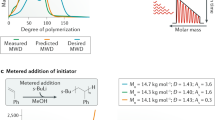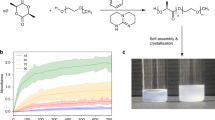Abstract
The chain conformation of polymers plays an important role in controlling their phase behaviour and associated material properties. In the case of flexible polymers, conformation is controlled by the degree of polymerization (DP), with low-DP polymers having extended polymer chains and high-DP polymers adopting random-coil conformations in solution and the bulk amorphous state1, and folded conformations in the crystalline phase2. Exceptions to this general rule are polymers that contain structurally rigid building blocks, or that are subjected to directional shear forces during solidification. The backbones of semi-flexible and rigid rod-like polymers, for example, are always extended in liquid crystalline and crystalline phases3,4,5, and gel-spun flexible polymers form extended-chain crystals2. Here we report a general strategy for the rational control of polymer conformation through the self-assembly of quasi-equivalent monodendritic (branched) side-groups attached to flexible backbones. At low DPs, the conical monodendrons assemble to produce a spherical polymer with random-coil backbone conformation. On increasing the DP, the self-assembly pattern of the monodendritic units changes to give cylindrical polymers with extended backbones. This correlation between polymer conformation and DP is opposite to that seen in most synthetic and natural macromolecules. We anticipate that our strategy will provide new approaches for the rational design of organized supramolecular materials6,7,8,9 in areas such as nanotechnology, functional films and fibres, molecular devices, and membranes, expanding the synthetic and technological uses of dendritic building blocks7,10,11,12,13,14,15.
This is a preview of subscription content, access via your institution
Access options
Subscribe to this journal
Receive 51 print issues and online access
$199.00 per year
only $3.90 per issue
Buy this article
- Purchase on Springer Link
- Instant access to full article PDF
Prices may be subject to local taxes which are calculated during checkout




Similar content being viewed by others
References
Flory, P. J. Statistical Mechanics of Chain Molecules (Hanser, New York, (1989)).
Keller, A. in Sir Charles Frank, OBE, FRS, An Eightieth Birthday Tribute 265–306 (Hilger, New York, (1991)).
de Gennes, P. G. in Polymer Liquid Crystals (eds Ciferri, A., Krigbaum, W. R. & Meyer, R. B.) 115–131 (Academic, New York, (1982)).
Ciferri, A. (ed.) Liquid Crystallinity in Polymers (VCH, Weinheim, (1991)).
Hardouin, F. et al. SANS study of a semiflexible main chain liquid crystalline polyether. Macromolecules 28, 5427–5433 (1995).
Lehn, J. M. Supramolecular Chemistry (VCH, Weinheim, (1995)).
Newkome, G. R., Moorefield, C. N. & Vögtle, F. Dendritic Molecules. Concepts, Synthesis, Perspectives (VCH, Weinheim, (1996)).
de Gennes, P. G. Soft matter (Nobel Lecture). Angew. Chem. Int. Edn. Engl. 31, 842–845 (1992).
Bissell, R. & Boden, N. Liquid crystals display new potential. Chem. Brit. 31, 38–41 (1995).
Fréchet, J. M. J. Functional polymers and dendrimers: reactivity, molecular architecture, and interfacial energy. Science 263, 1710–1715 (1994).
Percec, V., Johansson, G., Ungar, G. & Zhou, J. Fluorophobic effect induces the self-assembly of semifluorinated tapered monodendrons containing crown-ethers into supramolecular columnar dendrimers which exhibit a homeotropic hexagonal columnar liquid crystalline phase. J. Am. Chem. Soc. 118, 9855–9866 (1996).
Balagurusamy, V. S. K., Ungar, G., Percec, V. & Johansson, G. Rational design of the first spherical supramolecular dendrimers self-organized in a novel thermotropic cubic liquid-crystalline phase and the determination of their shape by X-ray analysis. J. Am. Chem. Soc. 119, 1539–1555 (1997).
Tomalia, D. A. & Durst, H. D. in Topics in Current Chemistry Vol. 165 (ed. Weber, E.) 193–313 (Springer, Berlin, (1993)).
Amabilino, D. B. et al. Self-assembly of [n] rotaxanes bearing dendritic stoppers. J. Am. Chem. Soc. 118, 12012–12020 (1996).
Percec, V., Chu, P., Ungar, G. & Zhou, J. Rational design of the first nonspherical dendrimer which displays calamitic nematic and smectic thermotropic liquid crystalline phases. J. Am. Chem. Soc. 117, 11441–11454 (1995).
Casper, D. L. D. Movement and self-control in protein assemblies. Quasi-equivalence revisited. Biophys. J. 32, 103–138 (1980).
Levine, A. J. Viruses (Freeman, New York, (1992)).
Klug, A. From macromolecules to biological assemblies. Angew. Chem. Int. Edn. Engl. 22, 565–582 (1983).
Ackermann, A. W. & Berthiaume, L. Atlas of Virus Diagrams (CRC, New York, (1995)).
Hudson, S. D. et al. Direct visualization of individual cylindrical and spherical supramolecular dendrimers. Science 278, 449–452 (1997).
Kwon, Y. K., Chvalun, S. N., Blackwell, J., Percec, V. & Heck, J. A. Effect of temperature on the supramolecular tubular structure in oriented fibers of a poly(methacrylate) with tapered side groups. Macromolecules 28, 1552–1558 (1995).
Sheiko, S. S., Gauthier, M. & Möller, M. Monomolecular films of arborescent polystyrene. Macromolecules 30, 2343–2349 (1997).
Wainwright, S. A. in Biomimetics. Design and Processing of Materials (eds Sarikaya, M. & Aksay, I. A.) 1–12 (AIP Press, New York, (1995)).
Wintermantel, M. et al. Lyotropic phases formed by molecular bottlebrushes. Angew. Chem. Int. Edn. Engl. 34, 1472–1474 (1995).
Hardouin, F. Mesomorphic properties and SANS conformational study in different liquid crystalline polymers. Macromol. Symp. 98, 329–339 (1995)).
Thomas, E. L., Anderson, D. M., Henkee, C. S. & Hoffman, D. Periodic area-minimizing surfaces in block copolymers. Nature 334, 598–601 (1988).
Percec, V., Ahn, C.-H. & Barboiu, B. Self-encapsulation, acceleration and control in the radical polymerization of monodendritic monomers via self-assembly. J. Am. Chem. Soc. 119, 12978–12979 (1997).
Acknowledgements
This work was supported by the US NSF, the UK Engineering and Physical Science Research Council, the Synchrotron Radiation Source at Daresbury (beamtime and technical assistance), the Deutsche Forschungsgemeinschaft and a Humboldt research award (to V.P.).
Author information
Authors and Affiliations
Corresponding author
Rights and permissions
About this article
Cite this article
Percec, V., Ahn, CH., Ungar, G. et al. Controlling polymer shape through the self-assembly of dendritic side-groups. Nature 391, 161–164 (1998). https://doi.org/10.1038/34384
Received:
Accepted:
Issue Date:
DOI: https://doi.org/10.1038/34384
This article is cited by
-
Visualization of Two-dimensional Single Chains of Hybrid Polyelectrolytes on Solid Surface
Chinese Journal of Polymer Science (2021)
-
Synthesis and properties of thermo-responsive azobenzene-based supramolecular dendronized copolymer
Polymer Bulletin (2018)
-
Light-induced unfolding and refolding of supramolecular polymer nanofibres
Nature Communications (2017)
-
Observation of polymer chain structures in two-dimensional films by atomic force microscopy
Polymer Journal (2016)
-
A supramolecular helix that disregards chirality
Nature Chemistry (2016)
Comments
By submitting a comment you agree to abide by our Terms and Community Guidelines. If you find something abusive or that does not comply with our terms or guidelines please flag it as inappropriate.



